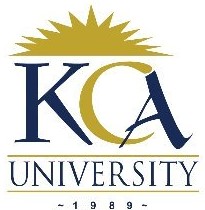
UNIVERSITY EXAMINATIONS: 2014/2015
ORDINARY EXAMINATION FOR THE BACHELOR OF SCIENCE
IN INFORMATION TECHNOLOGY
BIT 3107 WIRELESS NETWORKS TECHNOLOGIES DISTANCE
LEARNING
DATE: APRIL, 2015 TIME: 2 HOURS
INSTRUCTIONS: Answer Question ONE and any other TWO
QUESTION ONE
a) Discuss the politics of the electromagnetic spectrum. (6 Marks)
b) Assume a communications channel with an intended capacity of 20 Mbps. The
bandwidth of the channel is 1 MHz. Determine the signal-to-noise ratio required
in order to achieve the specified capacity. (4 Marks)
c) The wireless personal communications industry has moved from the traditional
analog technology such as FM (FDMA) to digital technologies such as TDMA
and CDMA. State four reasons that account for this. (4 Marks)
d) With the aid of relevant diagrams, describe Very Small Aperture Terminals (and
satellite) communications. (7 Marks
e) State the following basic features of GSM:
(i) Access method (1 Mark)
(ii) BS transmission band (1 Mark)
(iii) MU transmission band (1 Mark)
(iv) Channel bandwidth (1 Mark)
(v) Users per channel (1 Mark)
f) Identify four significant strengths that wireless communications systems have
over their wired counterparts. (4 Marks
QUESTION TWO
a) ITU is divided into three main sectors: ITU-R, ITU-T and ITU-D. Discuss the
roles of each of these three standards bodies. (6 Marks)
b) What three things differentiate wireless technologies? (3 Marks)
c) (i) What is multipath? (2 Marks)
(ii) Explain how multipath affects wireless communications (4 Marks)
d) The level of performance of an 802.11 WLAN is dependent on a number of
important environmental and product-specific factors. Access points will
automatically negotiate the appropriate signaling rate based upon environmental
conditions. State any five of these environmental conditions. (5 Marks)
QUESTION THREE
a) There are three major categories of threat that lead to unauthorized access: War
drivers, Hackers (Crackers) and Employees. Discuss these threats in detail.
(9
Marks)
b) With the aid of diagrams, describe the following types of antenna:
(i) Yagi (4 Marks)
(ii) Log-Periodic (4 Marks)
c) Describe briefly the following IEEE standards:
(i) 802.11d (1 Mark)
(ii) 802.11e (1 Mark)
(iii) 802.11h (1 Mark)
QUESTION FOUR
a) Because the amount of frequency spectrum available for mobile cellular use was
limited, efficient use of the required frequencies was needed for mobile cellular
coverage. In modern cellular telephony, rural and urban regions are divided into
areas according to specific provisioning guidelines. Deployment parameters, such
as amount of cell-splitting and cell sizes, are determined by engineers experienced
in cellular system architecture. Provisioning for each region is planned according
to an engineering plan that includes
cells,
clusters,
frequency reuse, and
handovers
Discuss briefly each of these concepts. (10 Marks)
b) Information can be either analog (e.g., sound) or digital (e.g., computer data).
Over the years, telecommunications systems have evolved from analog to digital.
(i) Briefly explain the essential steps necessary for an analog signal to be
converted to digital signal. (6 Marks)
(ii) By making suitable assumptions, determine the capacity in kbps necessary
to carry a 20 kHz tone. (4 Marks)
QUESTION FIVE
a) Define the following terminologies in relation to satellite communications:
(i) Earth Stations (1 Mark)
(ii) Uplink (1 Mark)
iii) Downlink (1 Mark)
(ii) Transponder (1
Mark)
(v) Elevation angle (1 Mark)
b) With the aid of diagrams, given the bit stream below, encode it using:
(i) Bipolar-AMI (2 Marks)
(ii) Manchester (2 Marks)
(iii) Differential Machester (2 Marks)
1 0 1 1 0 0 1 0
c) Discuss the use of VSATs for communications highlighting a description of what
they are, how they operate, underlying reasons for their use, data rates and
frequency bands. (9 Marks)
